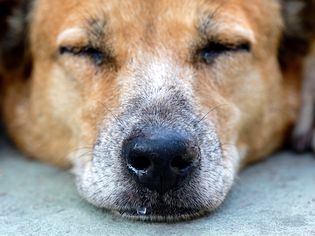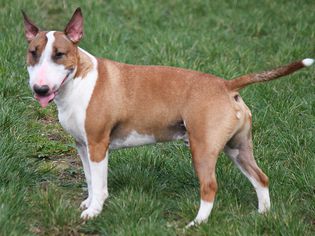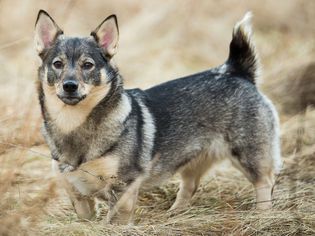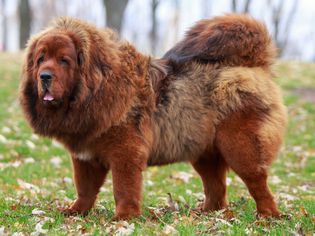Puggle: Dog Breed Characteristics & Care
Puggles are a cross of the pug and beagle dog breeds. This small dog breed is popular as a companion to families and individuals alike; they tend to be loving pups with a bit of a stubborn streak. Of course, every Puggle has a unique personality. You never know which parent breed they’ll take after the most.
We talked with vets to learn all about the puggle, including their characteristics, care needs, health, and history.
Breed Overview
GROUP: Hybrid
HEIGHT: 10 to 15 inches at the shoulder
WEIGHT: 14 to 30 pounds
COAT: Short
COAT COLOR: black, fawn, gold / yellow, red (bicolor, sable)
LIFE SPAN: 10 to 15 years
TEMPERAMENT: Energetic, friendly, playful
HYPOALLERGENIC: No
ORIGIN: United States
Characteristics of the Puggle
Puggles inherit playful and outgoing personalities from both their beagle and pug parents, says Nell Ostermeirer, DVM, spokesperson for Figo Pet Insurance. However, a mix of their personalities can also sometimes lead to a stubborn streak.
Beagles were bred as independent hunters, while pugs are known for their charming persistence in getting what they want. Early socialization and positive reinforcement training can help your puggle develop into a well-mannered family companion. “Puggles may bark at strangers, but they are generally too friendly to be a guard dog,” Ostermeirer adds.
| Affection Level | Medium |
| Friendliness | High |
| Kid-Friendly | High |
| Pet-Friendly | High |
| Exercise Needs | Medium |
| Playfulness | High |
| Energy Level | Medium |
| Trainability | Medium |
| Intelligence | Medium |
| Tendency to Bark | High |
| Amount of Shedding | Medium |
History of the Puggle
The creation of the puggle breed is credited to dog breeder Wallace Havens in 1980s Wisconsin. His goal was to develop a small companion dog with more pep than a pug but less wanderlust than a beagle. In reality, a puggle can fall anywhere on the pug-beagle personality spectrum.
Pugs trace back centuries to ancient China, says Teresa Manucy, DVM, a veterinarian at Chewy. The pampered lapdogs were prized companions by Chinese imperial emperors and later, English royalty. Beagles, on the other hand, were bred as working dogs in England for hunters on foot. They later arrived in America for rabbit hunting.
Puggles' popularity boomed in the 1980s and again in the 2000s, thanks to celebrity owners like Uma Thurman and Julianne Moore. Social media puggle stars like Earl the Grump and Bentley the Puggle keep modern-day animal lovers swooning over the breed.
Puggle Care
Puggles are energetic pups who need daily exercise, and their short coat isn’t high maintenance but does require weekly brushing. They adapt well to busy homes with children or other pets and don't tend to tolerate being left alone for too long, especially without toys or other enriching items. “This can cause them to act out with excessive barking, chewing, digging, or house soiling,” Manucy says.
Exercise
Puggles need at least 30 minutes of exercise daily, Ostermeirer says. They enjoy a variety of activities, such as going for a walk, romping around at the dog park, or playing with their favorite toys indoors.
According to Amanda Chambers, DVM, puggles may inherit varying facial structures—some with a "squished" face like their brachycephalic pug parent and others with a longer face like a beagle. While both beagles and pugs can be chewers and offering chew toys is important, consider your puggle’s jaw size when selecting the best chew toys.
Given their beagle roots, puggles may have a propensity to explore. Keep outside exercise safe by securing your puggle in a fenced yard or by keeping them on a leash.
Grooming
Puggles inherit a short, low-maintenance coat from their parent breeds. Like the beagle, they may even have a water-resistant coat that doesn't pick up much debris, an advantageous trait for hunting dogs. However, puggles do shed. Manage loose fur on your pup and around your home with weekly brushing.
Training
“As for any dog, positive reinforcement is the best training method,” Ostermeirer says. This entails rewarding your puggle when they do as they are asked or respond to a command. “Most puggles love food (because most pugs and beagles love food!) so using high-value treats is the most common form of positive reinforcement but attention and praise also work,” she says.
Puggles can inherit a stubborn streak, perhaps influenced by the pug's royal heritage. Keep training sessions short, positive, and free from distractions.
Common Health Problems
According to Ostermeier, puggles can enjoy lifespans of up to 15 years. To ensure a healthy start, choose a reputable breeder who tests their puggles for common genetic diseases. Consider pet insurance to help manage lifelong veterinary costs.
Puggles may be prone to the following health conditions:
- Brachycephalic syndrome: Breathing problems and overheating due to their flat faces.
- Skin infections: Regular cleaning of skin folds helps prevent infections, Manucy says.
- Patellar luxation: The dislocation of the kneecap
- Eye problems: Such as dry eye
- Musladin-Lueke Syndrome (MLS): A genetic disease that is common in beagles affecting connective tissues of the bone, heart, skin, and muscles. Reputable breeders will test puggle puppies for MLS.
- Hip dysplasia
- Obesity
Diet and Nutrition
“Puggles tend to be very food motivated,” Chambers says. Measuring out the appropriate amount of food for your puggle rather than providing access to an all-day buffet is the best way to prevent obesity and other health problems. If you’re unsure how much to feed your puggle, talk to your vet who will determine your pup’s appropriate daily caloric intake based on their weight (current and ideal), activity level, age, and health.
Like all dogs, puggles should eat quality commercial dog food for their life stage that meets the nutritional recommendations set by the Association of American Feed Control Officials (AAFCO).
Where to Adopt or Buy a Puggle
Do your research before buying a puggle puppy from just anyone. Reputable breeders prioritize testing for inherited diseases and welcome visits to meet the parents and puppies. You might also find a puggle at your local shelter, or there could be a puggle-specific rescue near you.
Puggle Overview
Puggles can make great companions who are playful and love their people. Because of their parent breeds, they are prone to barking and can be stubborn.
Pros of the Puggle
- Good with children and other pets
- Adaptable
- Friendly and playful
Cons of the Puggle
- May experience separation anxiety
- Can be stubborn
- Tendency to bark and chew
More Dog Breeds and Further Research
Interested in more small dog breeds that make excellent family companions? You may enjoy reading about these other dog breeds:
- Boston terrier
- Cavalier King Charles spaniel
- French bulldog
There is a wide variety of dog breeds out there, including mixes and mutts. With a little research, you can find the right one to bring home
- Are puggles good house dogs?
Puggles make excellent house dogs and are adaptable to home with children and other pets. However, without adequate exercise (at least 30 minutes daily) and mental stimulation, puggles may act out with excessive barking, chewing, digging, or house soiling, Manucy says.
Do puggles bark a lot?Puggles are good watch dogs because they tend to bark at strangers. Keeping your puggle well-exercised and socializing them from a young age will prevent excessive barking.
RECOMMENDED NEWS

Can Dogs Eat Zucchini? Everything to Know About This Hardy Summer Squash
Can dogs eat zucchini? Yes! Zucchini is a safe and nutritious snack option they can eat i...

Reasons Why Your Dog Has a Runny Nose
When people develop a runny nose, they usually know why. Illnesses, environmental debris,...

Miniature Bull Terrier (MBT): Dog Breed Characteristics & Care
Native to England, miniature bull terriers (or MBTs) are compact dogs with triangular eye...

Swedish Vallhund: Dog Breed Characteristics & Care
The Swedish vallhund is a small-medium herding dog breed from Sweden that has a short but...

Entlebucher Mountain Dog: Facts for Future Owners
The medium-sized Entlebucher mountain dog belongs to the Sennehund family, a group of fou...

Tibetan Mastiff: Dog Breed Characteristics & Care
The Tibetan mastiff is a rare, large dog breed from Tibet with a massive, towering frame,...






Comments on "Puggle: Dog Breed Characteristics & Care" :